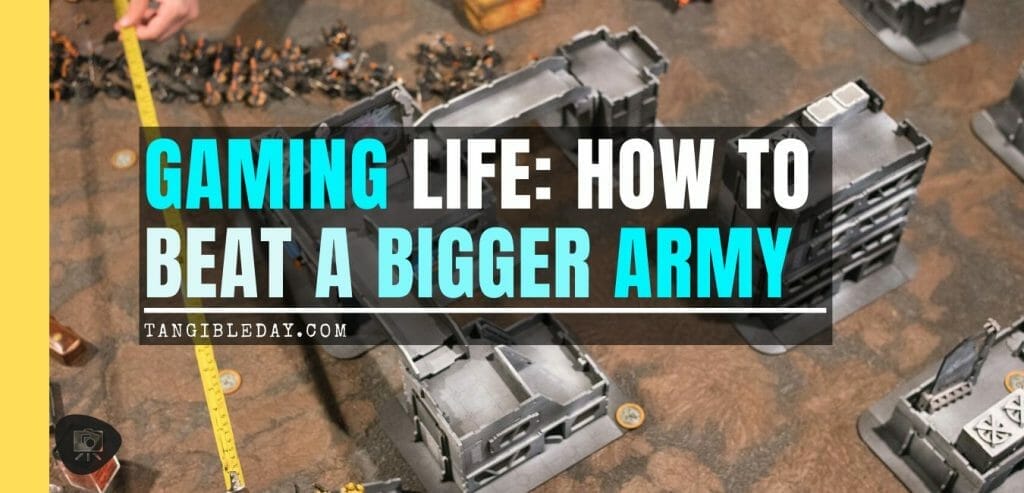Ever face an epic battle against a larger force? Are you a tabletop gamer looking for ways to win against a bigger army? Maybe, you’re in a fight against an opponent who seems to have more resources than you. Whether you’re a wargamer, a business person, or in academia, knowing the principles for winning a battle against the odds can come in handy. Much of military history is replete with examples of how epic battles were won against a larger army.
In this article, I share 4 principle lessons I’ve learned through my experience and research over the years as a gamer, scientist, father, and entrepreneur.
Why is fighting smarter a key to victory?
I hate cliches, so let me dive in with a quick preamble backstory.
I’ve fought and won with bad odds stacked against me. When 3 kids want something from you, the noise and neediness, rip at the heartstrings of your fatherly sanity (3 to 1). When you’re making a case for finishing grad school with a dissertation committee (5 to 1) and your science has flaws (the field is never perfect), you must find a way to assimilate (i.e., convince/convert) the opposition through careful argument.
In miniature gaming, your objectives are clear but victory is far off, you can either surrender or dig deep and find the conditions to pull the win. Warhammer 40k, Warmachine/Hordes, Age of Sigmar, and other tabletop wargames are incredible ways to exert your fighting prowess in a proxy world.
When your model count is low and your opponent has a bigger army, you can bring your life’s experience to bear and still win. And, vice versa. Lessons of history, lessons from gaming, are all the same in principle concept, and you should internalize it.
You can win against a larger army, force, situation, whatever. But, how do you do it?
Continue reading for 4 key principles for how to beat a bigger army (or situation).
Here are the 4 principles for how to win against a larger force:
- Gain advantage in situational context
- Maintain tactical superiority
- Obtain advantage in technology
- Better discipline
For more details and application to miniature gaming, life, and more, you can read on or skip below.
Poor Leadership Causes the Most Loss
Even if you have a lot more resources, better technology, or sheer numbers, you will lose if the leadership is poor. In business, the rise or fall of a company often comes down to the confidence of the company in the management and decisions of the CEO (Chief Executive Officer). Of course, this is a broad brush I paint with, but it is leadership that contributes most to the winning or losing of battles.
Confidence in the ability of the team to win, whether it is against the statistical odds, is a powerful factor in achieving victory. A leader’s vision, as it is often called, or madness by some, is the foundation for all victories.

There must be a leader in every situation, where a team is involved, e.g., business wargaming. Sometimes a group of people see a person as the leader, often an individual with an alpha personality. Though, a person being an alpha isn’t always a prerequisite to great leadership (source). In this case, the individual has something in them that makes them the natural leader.
In other situations, a person may not have a choice. They are placed in a situation where they must lead. Tabletop wargamers are such leaders. You go into a game situation where you muster your miniature forces (plastic, pewter, or resin) in a pitched battle against a opponent whose goal is to also win. Here, in the tabletop gaming scenario, your leadership and decision making skills are put to the test. You either thrive to die as a good or bad self-made leader.
Two Traits Make a Great Leader in Any Fight
- Grit
- Intellectual agility
1 – Grit
Grit is the attribute that says in the face of overwhelming odds, “We can still do this! Fight on!”. A leader with grit will not quit. Look at the Battle of the Bulge (see “Bastogne” 6th episode of Band of Brothers) in World War 2. The allied forces surrounded by a larger force of Nazis who held their ground for what must have seemed like an eternity did not give up. When offered terms to surrender in 1944, the response by General Anthony McAuliffe was “nuts!” (source). Many have argued that this was a major milestone and turning point in the war against fascist Germany.
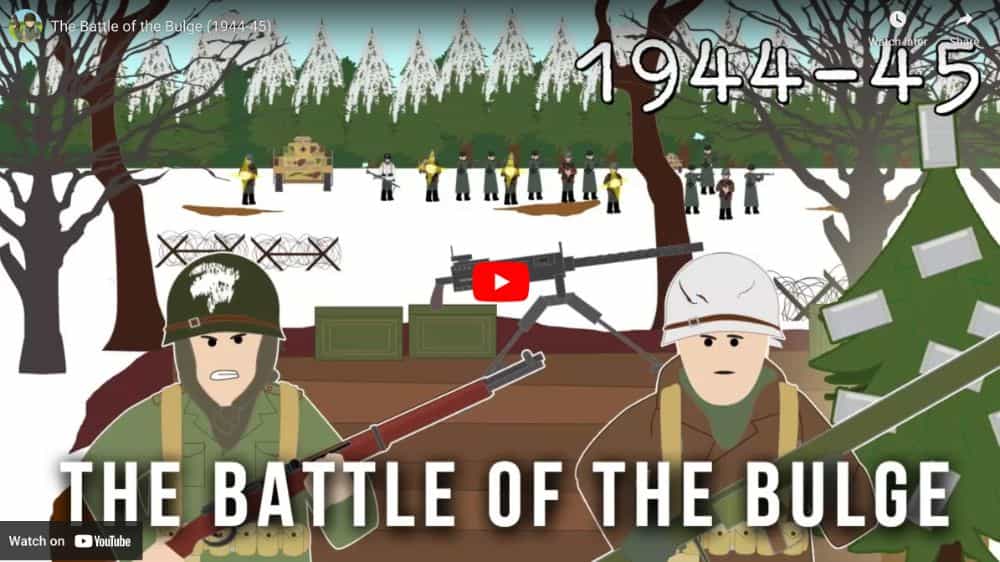
Another great example is in the movie “The 300“, where the Greek Spartans are forced into situation against a huge enemy Persian force. Grit and sheer will put the Spartans there, and it would take countless lives by the enemy to bring them down.
A leader with grit doesn’t know hopelessness. In fact, the natural inclination of a leader with grit is to take negative information and leverage it into something positive. Instead of thinking about who to blame, or what dumb decision was made, the leader with strong perseverance saves his/her energy to find solutions.

2 – Intellectual agility
This latter point also relates to the idea of intellectual agility. A strong leader doesn’t stand still, intellectually. They are constantly working the problem. In battle, the situation never stays the same. As the scenario shifts underneath him, instead of sinking and reacting, an effective leader has already anticipated the change. They are one step ahead and so the dynamic circumstance does not surprise him. In fact, it is the really amazing leaders who shift the ground.
Making strategic decisions under time-pressure takes enormous energy. With some individuals, this is paralyzing. You’ve seen it before, the effects of analysis-paralysis. Maybe you’ve seen during a board game session, where one player just bogs down with an inconsequential decision, yet must analyze each and every bit of info. Being agile in battle means you prioritize your energy and devote it toward priorities.
A key aspect in a leader with great intellectual agility is the skill of being able to quickly create a priority hierarchy. They will know when to triage ideas, dump them in the trash, and when to execute resources toward a goal. Developing intellectual agility takes practice and experience. It is why combat veterans are more valuable in a battle against worse odds than fresh rookies. In the context of tabletop wargaming, the more games you play, the quicker and more skillful you will become when making hard game-winning mental calculations and decisions.

Lastly, although I don’t mention it as a key trait, it has been something I noticed in many people I’ve worked with in team environments. The leaders I most respect have humility. These are people who are amazing at their jobs, but know when they may lack skill, knowledge, and seek out the strengths of their team. They are open to new ideas, innovations, and yet still carry the risk and burden of potential failure. They share successful outcomes with their group, but own up to mistakes.
Whatever your battle, in tabletop mini wars, business, or elsewhere in life, good leaders can turn bad situations into good ones. They can turn what might be a losing scenario into a comeback win. On the other hand, a poor leader is the first ingredient in a recipe for failure.
4 Principles for Winning a Fight Against a Bigger Army
- Gain advantage in situational context
- Maintain tactical superiority
- Obtain advantage in technology
- Better discipline
In historical context, whenever a small army beat a bigger army, they had gained one or more of these advantages of context, tactics, technology, or discipline. While you may find yourself with a smaller miniature army, you haven’t quit. Look to gain these traits in yourself, or diminish your opponent in their ability to use any of these 4 elements against you.

Principle #1 – Gain an Advantage in Situational Context
Almost every tabletop wargame starts off with two (or more) forces aligned against the other on a battlefield with neutral spatially-relevant elements, e.g., terrain features, objective markers. The more information you have about these elements on the tabletop, the better situational context you’ll have. In other real-life terms, this is the topographical geography your army has decided to fight in.
In historical context, geography is the famed example of how a smaller army has beaten larger armies. The gained information of knowing the situational context, the geography, and the leveraging of that information toward battle has made for some epic comebacks, or devastating losses for an opposing force. Again, I bring up the example of the Spartans fighting off the Persians at the Battle of Thermopylae chokepoint, or in early conflicts of the Samurai against the colonial Japanese army as seen in the The Last Samurai movie.
In your Warhammer 40k, Bolt Action, or Age of Sigmar game, are you able to use your smaller model count army and choose the tabletop “ground” where you will engage the enemy? Can you make the enemy’s strength in number less important to winning the fight? Is there a way to use line of sight rules to make having more models a weakness; maybe, where rear rank models can’t do anything in the battle?

When you’re playing a tabletop game look for ways to exploit the terrain and the context. Look for ways to channel a larger number of enemy models into a smaller tabletop area, e.g., reducing the frontal combat surface, diminishing the advantage of number. If you can do this and hold a strong “center”, your force can move to attack a weaker enemy flank.
Does this work in every tabletop wargame? Probably not. But, in principle, you can see how leveraging situational context can help a small force outwit and destroy a larger force. Tactics like this are how Hannibal and his barbarians defeated larger Roman armies time and time again. Exploit geography and determine the context of a fight.
This idea of exploiting the situation also works in other context in life. Everyone enters competition or a conflict, whether it be with other people or in business scenarios. If you can control the situation where the conflict or competition happens, you will have the distinct advantage of influencing the final outcome. You can determine the place and time of meeting, for example. Maybe you can schedule a sales pitch at lunch time, when people are plied and distracted with great food and drink.
Or, on the other hand, you’re situationally aware of being in a place where you’re vulnerable. You may have a competitor who is also trying to control the how the scenario plays out. Did this particular agenda suit you? Was there a reward that seemed too good to be true at the end of some discussion? Look out for the worm at the end of a hook.
A key trait you must have for winning a fight where you are outnumbered is knowing when to act or wait. Patience is a virtue. Watching the circumstance unfold before you may be a better tactic than impulsively diving into a fight, even if pre-planned. There might be a surprising better opportunity that presents itself even if the opening situation seemed favorable already.
If your army is swarmed by 40k Orcs or Tyranids, retreat to better ground, find defensive positions, or circumnavigate the board to capture mission objectives. Proactively work the board state and make your opponent react to your decisions.
Here’s the take home for beating a larger force. Survey and exploit the situation to your advantage. Find suitable “ground” that emphasizes your strengths, but also diminishes the opposing force. Delay a fight, if possible; be patient and wait for opportunities to arise before committing your resources into battle.
Principle #2 – Maintain Tactical Superiority
Tactics are any actions or strategies that you carefully plan to achieve a specific goal (source). Oddly, many people underutilize tactical planning in many battles they face. This is also true for miniature wargamers, e.g., Warhammer 40k and the like.
Sure, you can create army lists and study ordnance loadouts and other synergies within your army. But, when the game starts and the models are deployed on the table, have you planned out what you’ll do in Turn 3? In other games, too, there are meta-tactics that you consider within a turn (e.g., in Warmachine, you ask “do I boost this roll?” or save my focus/fury for some other action). But, there’s more to tactics.
Your ability to make tactical decisions is based on a history of many experiences and knowledge you’ve gained through the outcomes of past battles, won or lost. Hannibal defeated many larger, well-equipped armies using the same tactical strategy for every victory. For example, the Roman military strategy never really changed, and they failed to adapt tactics to new situations. Although they were a powerful, technologically-advanced, and well-disciplined military fighting force, the Romans were relatively immobile compared to the Carthaginians (source).
The German Blitzkrieg or “lightning war” in WW2 was a tactic of using a highly-mobile army that concentrated it’s force in a small at a time (source). The idea was to use a “concentration principle” that used a single overwhelming blow against a specific target. The beginning of what we would call today “a surgical strike”. It proved very effective, and led to the rapid surrender of mainland Europe to Nazi occupation for several years.
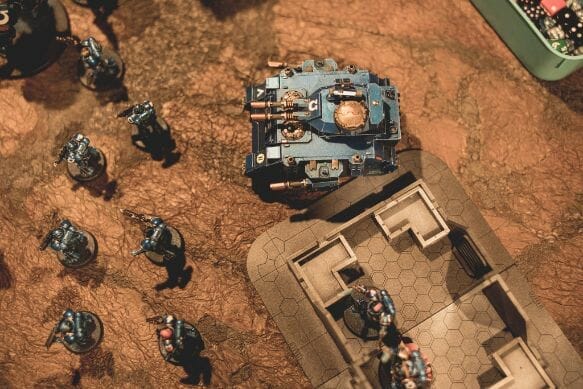
The atomic bombing of Hiroshima and Nagasaki in Japan in WW2 is another example of shock and awe. A single airplane, loaded with a single bomb, designed for a single target, through near-instant and massive destructive power resulted in a quick end to the War in the Pacific.
In modern times, the American’s use of the “Shock and Awe” tactic in Iraq, which lead to the downfall of Saddam Hussein’s government in 2003, is similar in principle to the German Blitz (source). In this case, the Iraqi forces surrendered in just under a month of main combat operations. Shock and awe reproduced the Nazi Blitz of using overwhelming power and force to paralyze the enemy’s perception of the battlefield situation.
This is especially possible wherein the enemy army is spread too thin.
If you’ve ever played Starcraft (the real-time strategy, RTS, video game), then you may be familiar with how the technologically advanced, but small numbered Protoss faction fights. Powerful, but small, an effective strategy with the Protoss is to use quick, mobile forces to surgically strike multiple times all over the battlefield map, e.g., the iconic Reaver drop. In a series of overlapping surgical strikes, attack and withdraw tactics, the Protoss diminishes the combat effectiveness of the enemy through distraction and attrition.
SunTsu, author of the The Art of War, instructed leaders and army generals to throw your opponent off balance by feinting attack, and redirecting your approach after your opponent has moved in a different direction. Once you control the rhythm of battle, with an opposing force reacting to your moves, you control the tabletop game, the business deal, or the presidential campaign race.
Distraction tactics divert resources from a larger, less mobile force (larger armies are generally slower to move about the field), which ends up “thinning them out”. A large force spread out over a greater area is one that can be torn apart, piece by piece. “Divide and conquer”, as they say (source). In the Bible, God used the same tactic, dividing a once single language into multiple human languages to compel people to stop uniting together in evil, i.e., via the building of the Tower of Babel (source).
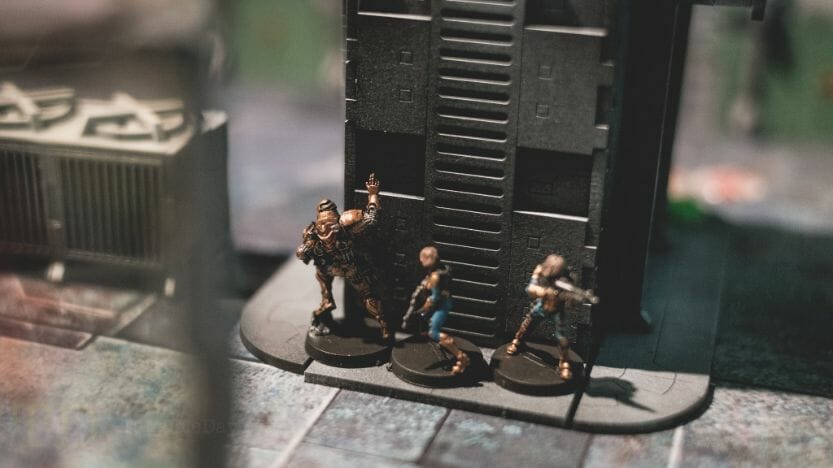
To summarize, you can beat a larger army or force to win by using and studying tactics. Using a smaller force, look for opportunities to win through rapid dominance over smaller portions of your larger opposition. Place them in a state of reaction to your moves, and place, if you can a method of distraction into your plan to spread out the enemy number across time and space. In this way, you can apply the tactic of conquering bite-sized pieces with your smaller, but concentrated force. Use speed and mobility, traits that generally escape larger armies.
READ MORE: 5 WAYS TO IMPROVE YOUR MINIATURE WARGAMING PHOTOGRAPHY
Principle #3 – Gain Technological Advantage
In strategy video games and tabletop miniature wargaming, the army with intrinsic technological advantage also generally have a smaller number of pieces to bring into battle. This, of course, is to maintain a sense of gaming fairness and balance.
Consider the 40k game where you bring your smaller number of Adeptus Custodes into a fight against the Astra Militarum (formerly known as the Imperial Guard). In any fight, the genetically and technological superior Adeptus Custodes are vastly outnumbered by the Astra Militarum human army. In some discussions on Reddit, it would either take hundreds of Guardsmen (maybe thousands) to defeat a single Custode on the battlefield, or a divine miracle (as lasguns or most conventional handheld weaponry can’t truly pierce the armor of an Adeptus Custode trooper).
In historical context, military history is full of stories of smaller armies with technological advantages defeating much more numerous opponents. The Mongolian recurve bow was an innovative weapon that stored and released much more energy than regular string bows of the same period (source). Using these weapons along with great horseback mobility during battle was a major force amplifier in conflicts against larger, yet stationary armies.
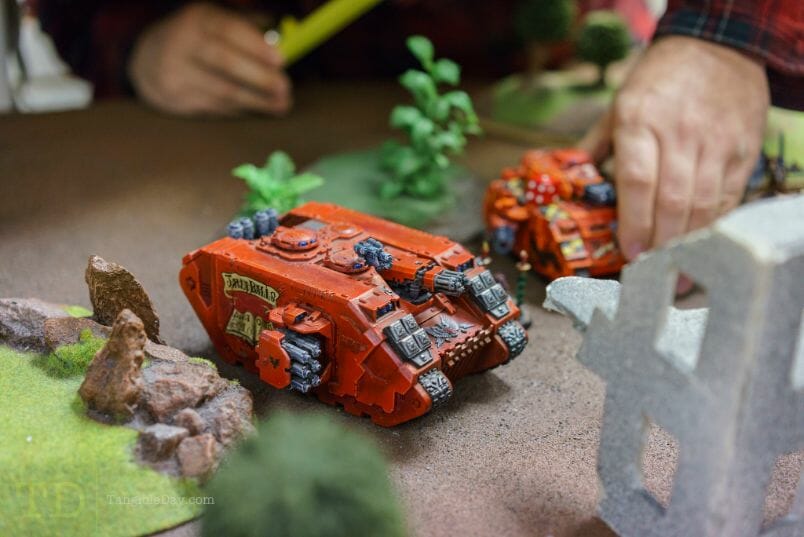
In my field of work (academia), incorporating new technologies and innovations in research can often lead to faster breakthroughs with a smaller labor force. Automation can make or break manufacturing companies who wish to compete against other countries who have easier access to cheaper human labor. A competitive advantage for any business is the application of technologies that increase efficiency, productivity, speed, and do so with less overall cost.
Of all the elements for how a smaller force can win against a larger opposition, technology is the most unreliable. Technology always changes, and the race for a better, faster, stronger “widget” will never end. Your competitive advantage gained with technological superiority is temporary. Though the space race for the moon is likely over between Nations (i.e., American landed on the moon first, contrary to conspiracy theorists), there’s still the private sector (e.g., Space X), and the unfulfilled human mission to Mars.
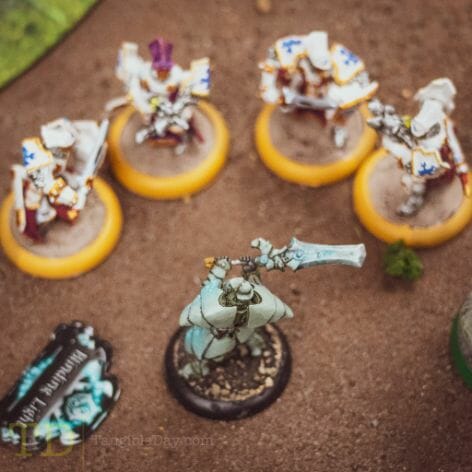
Of course, in the tabletop miniature gaming context, your technological advantage is static. The models in your army list won’t change. If you have a smaller number of less “advanced” capable models and are still in the fight, you can still leverage the other 3 elemental principles for winning. Additionally, armies and models with less technological advantage often have fewer choices to make during a fight. Maybe, you can redeem your limitations through your decision-making speed (i.e., maybe there’s a chess clock time limit in your game), or game your opponent into making poor choices.
Look, at the end of the day, innovation and technology are not sure fire winning advantages. Technology can be a limitation, too. New things you are not familiar with tend to also fail you. Are you fielding a model that looks amazing on paper in your game that you’ve not tested in a real game? Are you adopting an untried technology in your business or company? Airbrushes have unique advantages for painting miniatures and speeding up the work in your hobbies, but they are problematic tools, too (see this article).
Embrace technological advantages in your smaller army if you are looking for a competitive edge. But, remember that you are also taking a risk and will need to quickly redeem your technological advantage otherwise a smart opponent will neutralize them quickly. To shutdown a Tau offensive, you can engage their force in melee (to neutralize their superior technological range and gun fighting advantages).
Principle #4 – Better Discipline
Does your fighting force have discipline? In gaming terms, do you have discipline?
In the midst of battle, there’s a fog of war. Fog of war is the “…uncertainty in situational awareness experienced by participants in military operations” (source #1 and #2). In strategy video games, like Starcraft or Warcraft, this is often simulated through visual blocks of the map which prevent players from seeing what is happening outside their immediate vicinity of gameplay.
When you can’t see what is happening around your zone of influence, the area where you know what is happening, there is an encroaching sense of anticipatory anxiety. Have you prepared for all the possible external possibilities that may occur at any moment?

The fog of war is blinding, debilitating to an undisciplined person or organization. Are you surrounded by a larger number of people at a business sales meeting? They may ask you a hard question at any time about the product or service you’re trying to sell. If you have good discipline you will enter into battle well prepared and confident. You have rehearsed your speech, your response to the court lawyers who question your testimony.
When you play a tabletop strategy game, have you studied the abilities and capabilities of the models you command. When you face off against an opponent who has a larger army, your discipline in executing your plans will be like a rock in the middle of a roaring river. In chess gameplay, you aren’t impulsive. You don’t take the bait. Instead, you wait as the board state unfolds and you walk through the door you knew would open at the most opportune time. This is discipline.
Discipline is undergirded by active patience. Your discipline gives you the means to fight a much larger force, whose haphazard behavior in battle allows you to exploit weakness. Discipline comes with experience and training. Rehearsal reinforces experience through repetition. To gain discipline you need to play more, engage in the conflict you want to win in multiple scenarios, and incorporate that experience into an internalized mindset.
Do you hate giving presentations for work or school? Then, practice and drill in your oration skills until your tongue and mouth move while you sleep. When someone asks you a question about why you think and do certain things, don’t flail around and get emotional. Use the leadership traits (see above) of grit and intellectual agility with a dose of humility and you will produce a near automatic, reasonable and effective response. In life, have discipline and always be prepared to give a defense to everyone who asks you for what you are doing or thinking.
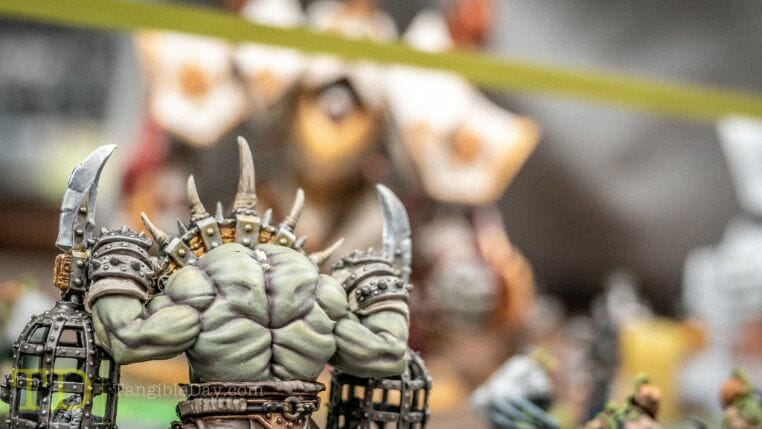
Remember, when you are outnumbered, discipline cannot alone help you win. But, failure to be disciplined will help you lose more battles than nearly any other factor that I can think of battles in games or life. The Incredible Hulk is one the most powerful physical beings in the Marvel Universe, winning fights against overwhelming odds. But, in almost all the fights where the Hulk was beaten, it was because he lacked discipline. He attacked haphazardly, when he should have waited a tad longer. Moved, when standing still would have been more advantageous.
When you roll the gaming dice, swing a sword, or enter into a political debate, it is natural for you to lose sight of the big picture. Your heart and mind race and your entire body ratchets up into a tight spring. Instead of losing focus, ultimately, you must rely on your training and discipline to find the best route to victory.
Conclusion
Have you ever been outnumbered? Maybe the situation appears overwhelming and surrender seems like the logical choice. Screw that. You’re alone or with a small group, yet you are in a fight for something. If it’s worth it to you, then lean into the principles that have guided the many victories of past battles in human history that were won against a larger opposition.
Sure, in many circumstances, winning a conflict is a simple numbers game. They have more. The principles I outlined are not a sure-fire win. They are merely compiled from my understanding of a body of knowledge and experience gained over time and in many circumstances, e.g., gaming and life.
In life (or wargaming), you have choices to either fight or withdraw. My final note to you is that winning, even against overwhelming odds, is oftentimes just staying in the fight until the peaceful end. 🖖
Thank you for reading!


Tangible Day on YouTube (Miniatures and More!)

